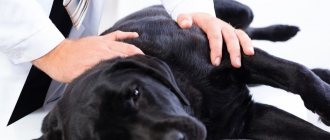Many owners panic if their dog is lost, but this method (at a minimum) will not give any results. Until your pet returns home, your task is to gather strength and do everything to help him. A lot of dangers await a dog on the street, and the more effectively you search for it, the greater the chance that it will return alive and unharmed. Quite often, four-legged animals find their way home on their own, but this can only be counted on if the pet is lost in an area that is well known to it.
Lost dog: what to do first
If the dog is missing, start searching immediately without waiting for it to return on its own. Use the phone to notify relatives, friends and acquaintances about the incident. The more people can be involved, the greater the chances of success of the operation.
Comb the neighborhood - algorithm and search methods
The search algorithm depends on the time since the loss. For the first 2 hours, search in a small area that includes:
- daily walking route;
- garages, basements and entrances of your own and neighboring houses;
- indoor walking areas and open fields, popular among dog walkers;
- nearest metro stations, passages and markets;
- places where stray animals are located;
- bushes and other thickets where the leash can easily get tangled.
Leave your clothes or your dog's favorite toy near your entrance. A familiar smell will help him find his way home. Don't forget to leave a person nearby who is personally familiar to your pet.
Ask and involve local dog walkers, janitors, grandmothers and children in the search. Describe your pet in detail and be sure to leave a phone number for contact. To be on the safe side, show a photo of the animal.
Don't forget that a frightened dog could jump into a vehicle. For this reason, it is better to conduct searches in groups in order to cover as large an area as possible.
Call your pet's name loudly and use squeaky toys to attract attention. During the first 24 hours, don’t stop looking for him even at night. Because of fear, the “lost” can fall asleep for the whole day. In this case, it is easier to find it at night.
Post advertisements
After 3 hours, it is recommended to write a missing person notice. Despite its simplicity, this method still remains one of the most effective. There are a few things to consider when writing your ad:
- Photo
. Use a color photo that takes up at least half the page. Black and white and small images are more difficult for passersby to perceive.
- Text size
. Fill the remaining space on the page with large text. Focus on the usefulness of the information, not the quantity.
- Heading
. Leave the largest font for your nickname and exact reward amount. The last point is very important, since possible overexposure costs money. Knowing about compensation, people are much more willing to help.
- Place of loss
. Indicate the area without going into detailed details.
- Distinctive features
. Describe the location of the unusual spots, coat color, and approximate size. Do not indicate the brand number and breed to reduce the number of scammers. Mention only the similarities and add a note about the presence of a skin disease. This false information will discourage attackers from coming into close contact.
- Contact phone number
. Along with the main number, be sure to indicate an additional number (relative or friend). In this case, the person who found the dog will definitely be able to call you.
Place printed flyers in plastic files and secure with staples. Such protection will prevent damage during precipitation. Post notices all over the city, starting from places of daily walk and ending with the nearest trains where a confused pet could jump.
Try to place leaflets in places with maximum crowds of people, these are:
- public transport stops;
- parks;
- veterinary clinics and pet stores;
- supermarkets;
- entrances.
Be sure to hand out announcements to passersby. Passing from hand to hand always gets a great response. It is also recommended to place flyers directly on the car to attract the attention of residents of several areas while on patrol with friends.
After receiving calls, do not rush to transfer money. Agree to meet a stranger only if accompanied by your friends, choosing the most crowded places possible.
Write to social network groups and forums
The Internet works real miracles, so do not forget to duplicate the information from the paper advertisement in all well-known social networks and on thematic forums. Ask your friends to repost the text posted on your personal page. Be sure to contact famous millionaire bloggers. The more subscribers see the text, the greater the chances of success. In addition to large public pages, do not forget to leave information in the communities in your area.
Can an animal return home on its own?
Animals should not be underestimated - the dog can return to its owners on its own. Even if the pet has gone quite far, thanks to its excellent sense of smell, it can find its way. If for any reason the dog gets off the leash and does not respond to the call, it is also capable of returning. But in the latter case, the presence of an emotional connection with the owner plays a significant role - wild animals tend to disappear forever.
On a note! If the animal does not respond well to commands and tends to run away, it is worth purchasing a special GPS collar. Through communication with the satellite, it will signal the pet’s location and speed up the search process.
There are special devices for constant monitoring of your pet.
What to do if your pet is found
First of all, you need to carefully examine him for fractures, wounds and parasites. You can take him to the vet right away. Then the dog needs to be washed, treated, fed and given the opportunity to sleep well. You also need to take the time to delete posts and express gratitude to all the helpers. If desired, pay a reward to the most active participants in the search.
Any owner of a four-legged pet should know what to do if the dog runs away and be prepared in advance for unforeseen circumstances. The initial task is to throw all your physical strength into the search, putting aside all other matters.
Where to go
Having figured out where to look for the missing dog, all that remains is to find out the institutions and places that are ready to assist in the search. In such a situation, it would be foolish to refuse support, so try to use all possible options.
Shelters
Due to constant overcrowding, the likelihood of ending up in the shelter is high only during trapping periods. They occur in autumn and spring. Contact all known institutions to confirm the nearest capture date. If it coincides with the day of disappearance, check more detailed details to identify your pet.
Veterinary clinics
If a dog is missing, the finder can try to find its owner using a brand or chip. The easiest way to obtain this information is from your veterinarian. Also, the need for treatment due to an injury or fear of leaving the “foundling” next to your pets may bring you to the veterinary clinic.
Police
If you are sure of theft, file a police report. This rarely produces results, but at least gets the attention of employees.
Additionally, request CCTV footage to check patrolled areas at different times. They can be found on webcam sites in your city. In addition to the location, you will need to indicate the date and time period. The necessary records will be ready in a couple of hours, but they can only be picked up at the police station after filing a missing persons report.
Media of any level and format
If you are sure that the reason for the disappearance is kidnapping, then be sure to contact the media. An article in the local newspaper or a short segment on television will help spread the word and reinforce the value of the police report. In this case, law enforcement officers will look for the dog with greater enthusiasm.
Internet resources
In addition to your own announcements on social networks and forums, do not forget to monitor announcements about found animals. A person may want to return the dog, but miss the information about his loss. In this case, he himself will create an ad in the group about the “lost ones.”
Also don't forget to check the free message boards. Criminals may try to sell your pet for more than the reward. In such a situation, you will have to enlist the help of the police.
Hope percentage
Having an address card or tag will help the pet return home.
Photo from the site classpic.ru “Search success is guaranteed in 80% of cases, even with not very active searches,” says Anastasia Shukaeva. “If the dog has a tag, then everything is much simpler and faster. And, by the way, a passport with a chip can then help prove that this is your animal,” the expert notes.
“I myself found all my lost ones, and with the help of personal searches. She went and called. For example, there was a case when an adopted dog that lived in our shelter ran away from its new owners. I arrived, and she responded to my voice, we found her in five minutes,” Anastasia cites her experience as an example. “But what helped me most was the online newsletter: a lot of people immediately called, reported the whereabouts of the dog, or sometimes held it until we arrived.”
A certain percentage of losses remain with the new owners. “Among my friends there are also those who kept the animal they found,” says Anastasia. – Most often this happens due to the fact that it was not possible to find the owners. But in the end, they themselves fell in love with the dog and realized that it was fate. These are, of course, happy stories. It’s much sadder when a lost dog disappears on the street and becomes homeless.”
Statistics and predictions for success
When purebred pets go missing, the chances of finding them are always higher. They are easier to distinguish from strays than ordinary mongrels. Special groups dedicated to helping specific breeds also contribute.
Another advantage of purebred origin is the presence of a mark. It is very easy to find the breeder, so it is better to notify this person in advance about the disappearance of your pet.
Owners of four-legged friends from the shelter should not despair either. At first, they are monitored by a curator, so you can always turn to him for help and support.
The chances of success increase if you have a brand, a chip and a token with the owner’s phone number. Eight out of ten missing people can be returned home.
Thoroughbred and mongrel - who has better chances?
A dog wearing a properly fitted harness.
Photo from the site myzooroom.ru Anastasia Shukaeva says that there are no exact statistics indicating which dog is faster. “But thoroughbreds are found, I think, more often. They are more noticeable and, I repeat, there are help teams for breeds, and people are increasingly turning to them immediately (both those who have found them and those who have lost them).
It’s easier to explain that a pug is lost than to say that a spotted mongrel with one erect ear and the other recumbent has disappeared.”
If your lost dog is purebred, you must inform the breeder . Because there is a possibility that your dog ended up with knowledgeable people, and they, having selected a purebred animal, will first check the brand, run it through the database, and call the breeder with a message about the find, explains Oksana Dubinina. “And if the dog is from a shelter or “curated,” be sure to inform the dog’s curator,” Oksana recommends. – People involved in adopting animals have a lot of resources to notify the whole world about the loss of a dog. This means there are great prospects for finding it.”
A dog is called “curated”. which was taken home from the shelter, and for which at first the activists of the shelter and its owners look after it. Recently, among animal lovers it is considered the correct and approved action not to buy a puppy from a breeder, but to save a dog from a shelter, so a “curated” dog is not an isolated phenomenon, but part of a new everyday life.
Oksana Dubinina cites as an example one of the many cases of her own experience of searching for a dog. “This happened to my handler dog. In the morning call: “Hello! Have you ever lost your shepherd?” I looked at my mongrels and said: “No, my houses.” “And she has your phone number written on her collar.” - “Please describe the dog and tell me where you found it?” - “Moskvoretskaya embankment...well, so thin, about 15 kilograms, red-haired with a dark muzzle.” - “Does he respond to Amalia?” – “Amalia, Amalia….Ohhh! yes, it responds!” And then I shout: “Oh! Girls, please hold it! We’ll pick it up now!” - “Yes, yes, she will be here, in our law office!” Meanwhile, I already had a message on my phone and unanswered calls from the owner Amalia. It turned out that the dog had wriggled out of the collar on which hung a tag with the owner’s phone number, but there was still a cord with my phone number. Half an hour later Amalia was home! The main thing is to approach your friendship with animals responsibly. The dog will not tell you his address and phone number, but you yourself can always prevent the loss or bring the dog back to you closer.”
How long can you continue searching?
There is no exact answer to this question. Sometimes four-legged friends are found within the first 24 hours, and sometimes years later. Dog lovers who have experienced such a misfortune advise not to give up until the very end. If acquiring a new four-legged family member will calm you and your children, make sure that if the missing pet returns, you will be able to leave both of them.
Tell others
No matter where you live, neighbors are a powerful resource that can potentially help you find your lost companion and even give you more helpful tips and information on how to find your missing dog.
In rural areas where your neighbors are not easily accessible in the neighborhood, post a missing dog flyer at high traffic businesses such as a popular local diner, post office or grocery store. Many of these commercial buildings have a public board that you can use for free, but if not, you can politely ask the staff if you can use their window space.
Why do dogs run away from their owners?
The chance of salvation is high, but still do not forget about the remaining 20%. Lost animals can die from hunger, thirst and cold. Also dangerous are busy roads and stray dogs, ready to tear to pieces any stranger on their territory. We should not forget about human cruelty.
Dire consequences can be avoided by following basic safety measures. All of them are aimed at preventing possible causes of escape and facilitating the search for a lost animal.
Possible reasons
Most often, four-legged friends get lost in the warm season, when their owners let them go for walks on their own. Once free, they may be afraid of crowds, the noise of cars, or simply become carried away by a squirrel in the forest.
During New Year's holidays, fireworks and firecrackers become the cause of escape. Even those walking on a leash are running away due to the incessant explosions. A moment of joy from sparkling fireworks can turn into real grief for the owner and psychological trauma for a four-legged friend.
Also, the likelihood of loss increases during the period of sexual hunting. Bitches in heat can easily snatch the leash and run away in an unknown direction in search of a gentleman. Young males show playfulness when they smell the scent of a female. If your pet becomes too problematic during sexual arousal, it makes sense to consider neutering surgery.
How to prevent escape
To prevent escape, take care of raising your pet and purchasing reliable ammunition. This will help:
- Completion of the UGS or OKD course. Knowledge of the “Come to me” command and an adequate reaction to noise are indispensable in a large metropolis.
- Regular use of a leash. Do not make exceptions for small breed dogs. Spitz and Yorkies are much more difficult to find than larger representatives. It is permissible to walk without a leash only in a fenced area with familiar dog walkers.
- Thorough check of equipment before each walk. Make sure that belts, metal rings, carabiners and other fasteners are intact before going outside. Try to tighten the harness or collar to prevent accidental tearing. But don’t forget about comfort, leaving space exactly the width of your finger.
- Increased attentiveness during estrus. This poses a danger not only for females, but also for males. If pets do not participate in breeding, then it is better to neuter them. This will eliminate the irresistible urge to reproduce and reduce the likelihood of theft.
- Avoid walking in the dark during the New Year holidays. If this cannot be avoided, then be sure to buy a glowing collar.
- Hunger is the key to returning home. Do not feed your dog before a walk, as a well-fed animal is ready for long adventures. But a hungry pet will remember that after a walk a hearty homemade lunch awaits him - and will not want to run away.
Attach a special address tag to the collar indicating the nickname and your contacts. It’s even better to secure the duplicate on a separate cord. This will prevent important data from disappearing if the collar is lost.
When choosing a collar, pay attention to models with a built-in GPS tracker. This device greatly facilitates the search. Chipping performs a similar task.
Do not allow your child to go for a walk with the pet unless accompanied by an adult. The baby will not only not be able to restrain the animal, but will also not be able to repel intruders. Non-disclosure of information about the cost and breeding value of the pet will also protect against theft. Never give out this information to strangers.
Amputations, stroke, exhaustion
Twelve-year-old Natalya Ilyashenko asked her parents for a Labrador named Boss about ten years ago. The nine-month-old puppy was given away by a family that had a child with an allergy to wool. The boss turned out to be an ill-mannered dog: he was not taught useful commands for walking. The Ilyashenkos immediately signed up for classes at a dog park in Sokolniki, half an hour’s drive from Korolev, where they lived. Natalya says that at the first lesson there was not a single person in the group with a correctly selected complete set of equipment.
The boss was let off the leash, but only at the edge of the forest, where other dog walkers gathered: “We were sure that he would not go anywhere, because he was interested here. And we didn’t yet know that this fireworks activity lasted about three weeks in total. We didn’t shoot ourselves.” Fireworks that evening were lit about 60 meters from the company. The dogs scattered, “some to their owners, some further into the snowdrift.” The boss could not be found; the lanterns in the forest only illuminated the path to the house.
A week later, when the parents had already begun to carefully explain to the teenager that the dog might not return, he came to the neighbors’ doorstep. But on his skin in the chest area there was a wound the size of a notebook sheet, and his bare skin was oozing ichor.
BossIllustration: Sonya Yankovskaya for TD
Animals that are missing for several days often find their way home maimed by other stray dogs or people. The dog Hera, for example, returned to Nina Glukhova two days later, but her long tail was “dangling by a thread.” Almost all of it had to be amputated, necrosis began. “Two months of IVs, antibiotics, daily injections in the back paw. Minus fifty thousand from the budget. And a lesson for life,” says Glukhova. And the Doberman Kairu, who knocked down the door of a wooden barn and ran away because neighbors had set off fireworks on the property, was found by a family acquaintance among a pack of stray dogs at the market. She was emaciated and deeply pregnant.
Some dogs become afraid of the street because of fireworks and even prefer to go to the toilet at home. The dog Junior from the Sapin family was so frightened by fireworks last New Year's Eve that for a couple of weeks he refused to go out at all. “I endured until the last moment, then I could at most crawl to the nearest tree. Several times I washed the entrance because he relieved himself at the elevator,” says Alina Sapina. Now the owners will celebrate 2022 with Junior in a car on the outskirts of Voronezh, watching movies from a laptop, and only return to the already quiet city in the morning.
Dog behavior specialist Pigareva says that the animal can retain fear of both the time of day (and if the explosion was in the evening, then it will be possible to walk only during the day) and the place where it heard the sound. So, for example, it was impossible to drag the collie Chase again to the Khimki stadium not far from his home, where he was hit by fireworks and began to tear off the leash with such force that he tore out four claws on his front paws, which is why two of his pads were amputated.
Instant heart attacks and strokes also occur among dogs. Four-year-old Yorkshire terrier Betty went limp and fell on her side when a neighbor two meters away threw a firecracker in the park without warning. While Tatyana Tsulaya was running with the dog in her arms to the house to take the car keys and go to the clinic, the animal began to have convulsions: its paws were stretched out, foam was coming out of its mouth. Tatyana stopped the car along the way and gave Betty artificial respiration. When she was brought home, Tatyana's father cried, watching the dog unsuccessfully try to get up. The next day the convulsions recurred, and the next day again. Betty suffered from them for several more years.
What to do if you find someone's dog
Finding yourself on the other side is no less exciting. First of all, people are afraid of the possibility of infecting their own pets, so only a few are involved in foster care. Despite this, there are many more ways to help a “lost” person.
Identification
If the animal is in no hurry to approach you, be careful. The stress experienced can turn into aggression. If you have seen a flyer about the loss or recently spoke with the injured owner, contact him by phone without letting the dog out of your sight.
Calm animals can be taken to a veterinary clinic or to volunteers. If there is a stamp or chip, they will be quickly returned to their owners.
If all possible identifiers (including the address number) are missing, you will have to follow the same algorithm as the owner. Online and offline advertisements can help here.
First days
The hardest thing is to get through the first few days after the death of a loved one, not only for you, but also for the dog. Just like people, not all animals cope with loss the same way. After the death of the owner, the dog may become distant and refuse to eat. According to PetHelpful, most dogs cope with loss by spending less time with people and refusing to eat, but some behave in some unexpected ways. Some dogs tend to become irritable, while others may become nervous or anxious. Unfortunately, finding a new home for your pet as soon as possible is important, but it can be difficult to balance moving and trying to help your dog cope with the loss. Most importantly, remember to maintain her routine as much as possible for the first few days. Use the same leash, food, bowls, bed, etc., and maintain a regular feeding, playing, and sleeping schedule. Stability and consistency are the key to successful adaptation of an animal. Dogs have very developed intuition, and they sense when something is changing. Reassure the animal that everything will be fine - this will help cope with the situation. Show the same degree of love as the previous owner - this will help him cope with the loss, and perhaps it will be easier for you to cope with grief.











